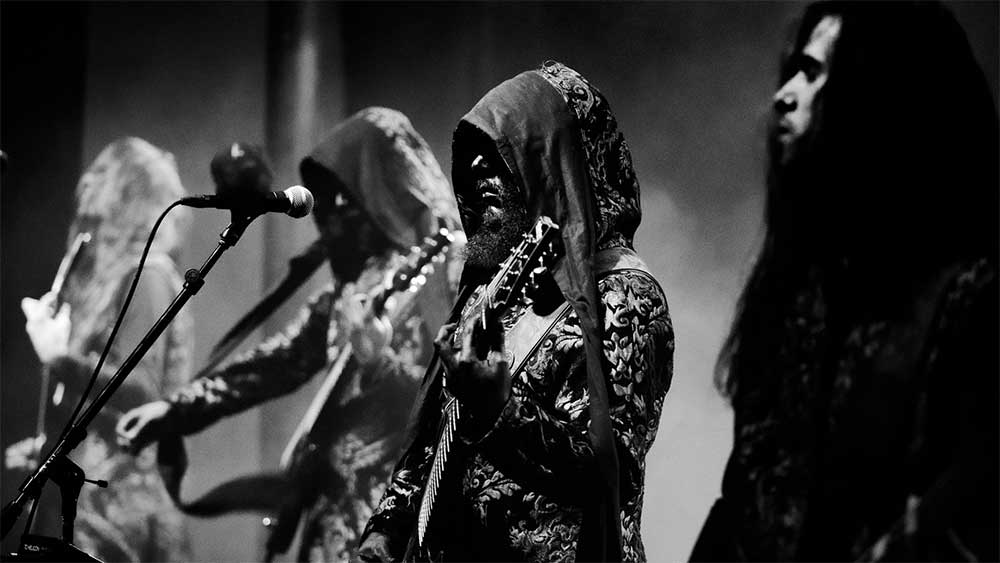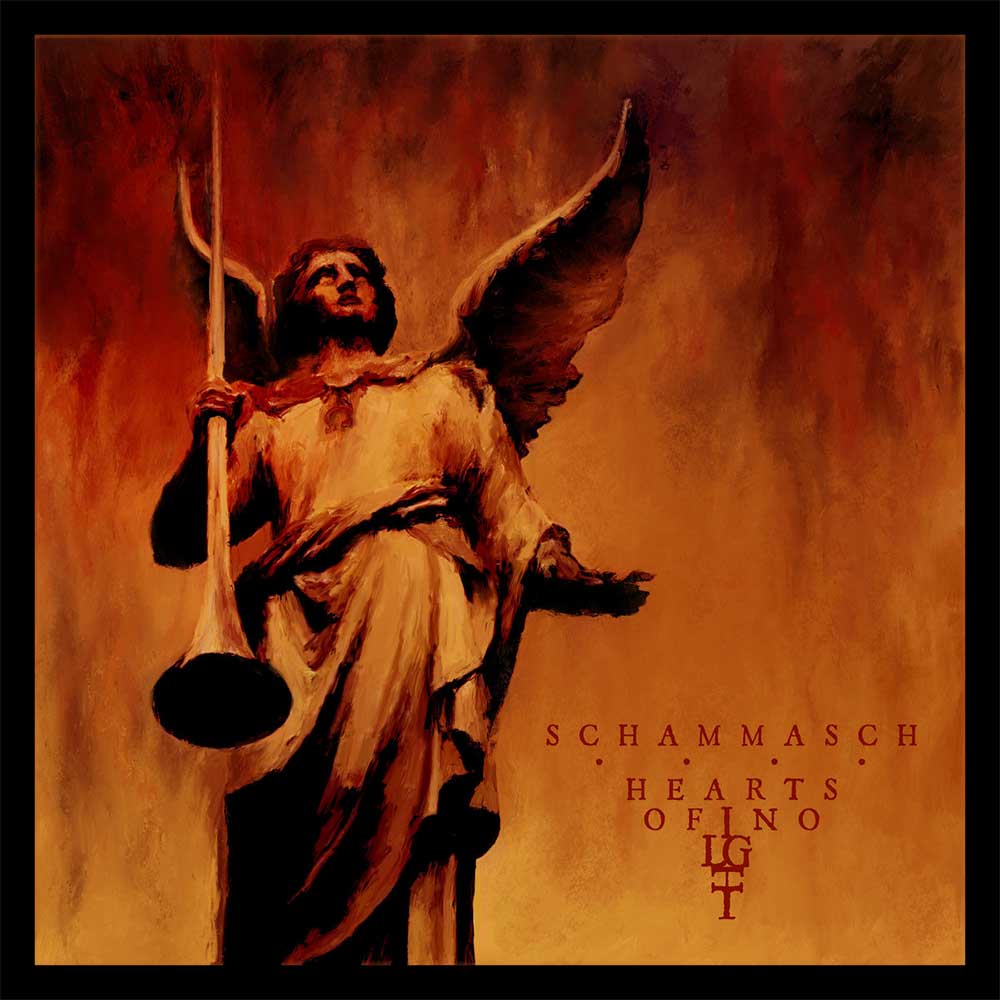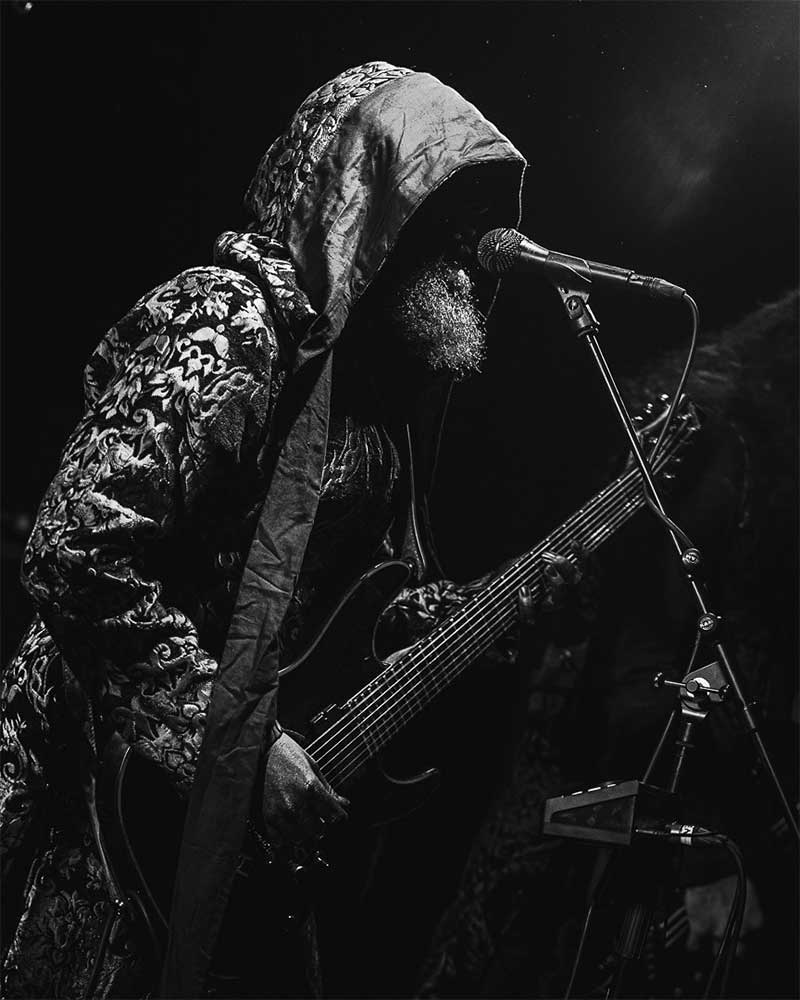Schammasch
2020-10-07
by Niklas Göransson
Winds that pierce the silence – a conversation about creative autonomy, musical integrity, and wielding otherworldly art as a weapon against modernity with C.S.R of Switzerland’s Schammasch.
– I regard “Hearts of No Light” as a sobering up; a return to a less metaphysically driven, more earthy, and far darker place than “Triangle” (2016) landed us in. “Triangle” was the pursuit of a state of overall acceptance and spiritual balance, whereas “Hearts of No Light” is infused with destructive, worn out, and more human sentiments. It’s somewhat of a personal confession – welcoming the harmful and negative aspects, as well as the general confusion of finding ourselves here after failing to reach the unobtainable. This wasn’t exactly easy to accept, but definitely necessary and very liberating. The album didn’t have any higher goals than being an accurate and honest expression of both the current personal state and our relationship to creativity.
“Hearts of No Light” was released by Prosthetic Records in November 2019. The fifth album of Switzerland’s SCHAMMASCH starts off with a piano piece – the result of a collaboration with Canadian pianist and photographer Lillian Liu. Whilst working on the record, C.S.R came across a video of Liu performing her own arrangement of DEATHSPELL OMEGA’s “Apokatastasis Pantôn”.
– Her playing had an enthralling, natural fluidity and grandeur which immediately drew me in. I’m not fond of classical music but really like the works of Chopin, and Lillian’s playing style shows a lot of the same natural fluidity found in his pieces. Like a stream of water: permanently in motion, sometimes powerful and furious and other times calm and gracious. A beautiful thing to watch and listen to. The piano is one of the instruments best suited for bringing an organic vividness into sound, and there had been multiple times in the past when I’d contemplated somehow incorporating it into SCHAMMASCH. Now, there was no question about it – no considerations. I immediately knew it had to happen. Acting essentially on pure instinct, I contacted her right away.
Did she work out her contributions before you entered the studio?
– There were a few ideas and instructions, but the most outstanding moments happened out of sheer improvisation. The part in “Winds That Pierce the Silence” was completely improvised. Lillian also talked us into recording her using a fork on the piano strings, which created the strange noises audible in “I Burn Within You” and close to the end of “Winds…”. We recorded a lot more material than what was ultimately included on “Hearts of No Light”, some of which might be used in the future. For example, we spent a lot of time on a Brendan Perry (DEAD CAN DANCE) cover, but, at some point, it no longer fit with the album’s core elements. I’m still hoping to find a place for it.

Does this happen a lot, coming across musicians you immediately feel called to work with?
– It’s only happened once before, a few years back. During the composition of “Triangle”, I stumbled over a documentary about a man who owned an ancient cloister in the southernmost mountains of Switzerland. Throughout his entire life, he’d amassed countless gongs and all kinds of exotic instruments; he used this collection to turn the entire monastery into a ‘klanghaus’, a sort of audio mansion. He offered sonic therapy and sound experiences to outside visitors. I immediately checked his website and, still watching the documentary, began writing him an email. The owner – who was actually called Bardo, he passed away two years later – found my proposal interesting and so invited me and Victor Bullock, the producer we were working with, to travel down there and record together for three days. This was a truly unforgettable experience and had a huge impact on how that album turned out. A lot of decisions in SCHAMMASCH are based on this kind of instinct: on moments of strong intuition.
SCHAMMASCH is often labelled ‘avantgarde black metal’. I’ve found that most musicians who end up lumped into similar categories tend to vigorously object, and C.S.R is no exception.
– I struggle to agree that this is a fitting description for us, especially the ‘black metal’ part. SCHAMMASCH is not a black metal band – we just do what we do. Our music does the label no justice, and vice versa. Honestly, I’d prefer not to categorise us at all, but, in one way or another, someone’s gonna do exactly this; there seems to be no way around it. Unlike most music labels, I don’t think of the term ‘avantgarde’ as defining specific sonic or technical characteristics, but rather as supporting its forward-going qualities: a sense of experimentation, exploring new territories, and overcoming boundaries. Regarded from this point of view, I find at least that part to be apt.
When you set out to re-invent your sound for a new album, do you have a vision beforehand or is it more of an intuitive process?
– I’d say both are true to some extent, more or less, on an individual case basis. Apart from using similar technical components, there’s no template as such when I begin writing new material. Usually, there are ideas, visions, and bits and pieces of music for a future record – even one that isn’t next in line. For example, when I started working properly on “Hearts of No Light”, I’d already written a twelve-minute piece for the second “Maldoror Chants” chapter. There are sparks. Instinct, experimentation, and time always play a major part; whenever I’ve tried rushing something, a point comes where a price has to be paid. So, I always try to make sure to spend enough time and consideration on everything. Generally, I can say that the older I grow, the more confusing things tend to get. I strive further away from actively trying to make sense of everything in advance; instead, I allow clarity to find me during the process, which is something I can always put my faith in.

SCHAMMASCH weren’t always this sonically adventurous. The 2010 debut album, “Sic Lvceat Lvx” was more of death/black hybrid with elements of doom metal. Four years later came “Contradiction”, which is where they began carving out a niche of their own.
– I’d say the main reason why our music turned out the way it did was due to the fact that we weren’t bound to any defined genre restriction; instead, whatever we created was allowed to grow in any direction, as long as it felt natural and stayed coherent and loyal to itself. Think of a tree out of which different branches reach in multiple directions and in various sizes and shapes, yet they always grow from the same trunk. However, in no way does this speak against art that’s more forcefully constrained to fulfil a specific purpose. Quite the opposite, actually. If it’s meant to be restricted in a meaningful way, there can be a lot of power in the limitation itself – as a tool.
Much of what C.S.R says about his creative process brings to mind past discussions about composition through what’s called flow states – a frame of mind which entails complete immersion in the task at hand, a tunnel-vision of sorts. The general consensus appears to be that the very finest ideas and musical pieces derive from this.
– This is absolutely something I’ve experienced from time to time and, furthermore, I’d also agree that the results of such moments are usually among the most satisfying. A perfect example is “A Paradigm of Beauty” from “Hearts of No Light”, which is basically a hymn to this creative energy – to the Muse itself. Fully constructing and developing a song to levels of total satisfaction usually takes me quite a long time. “A Paradigm of Beauty” was essentially finished in two days, something I’ve never experienced before. It’s also by far the most deviant piece I’ve written for SCHAMMASCH, which makes how I found it all the more interesting, and how great the song fits with the remaining material even though it, in a way, opposes the album’s very core. But in doing exactly this, it gave “Hearts of No Light” a missing piece in the puzzle that was necessary to connect all the dots. To me, this track represents artistic inspiration in the purest sense: it’s the most honest form of music I can create. Whatever meaning one ascribes to the word ‘divinity’, this was a divine experience to me. During such moments, a feeling of something transcending the ‘self’ takes over, like something lurking in the deepest depth breaking free from all the profanity. Maybe, in a way, similar to experiences that can take place through meditation or the use of psychedelic drugs. Pure energy that transcends the mundane ego and, for a short moment, lights up the divine spark within.
What do you think is the connection between art and divinity?
– Art is, or at least can be, one of the few remaining virtues that communicate or enhance sensitivity towards value, depth, life, death, and spirit: an underlying sort of awareness, and a push towards self-reflection. These are all characteristics currently being acutely suppressed and swallowed by modern society, because they are a thorn in its flesh. At least, I think they are. Self-reflection and awareness are powerful tools against the ever-growing, all-devouring shallowness, ignorance, and blindness. Art can act as their communicator, but, on the other hand, it can be a war cry – or a prophet offering alarmingly accurate visions of the future. In there, I see its gigantic worth: one that’s probably never been more needed than today. It’s a key to the sanctuary in one hand, and a weapon in the other. Of course, that might be an idealised and romanticised view; just like everything else in these absurd times we live in, the word ‘art’ is surely subjected to all the modern distortions.
Remaining on the notion that art is an expression of inherent divinity. If so, one might not necessarily want to engage with music created and performed by an individual one detests. If a composition is the sonic manifestation of the musician’s soul, then perhaps there should be an aversion against immersing oneself in its foul energy?
– I’d say that depends on where this distaste actually stems from. If it’s based on matters clearly affecting the artistic quality and motivations behind the music itself – my answer would be yes, there should be some aversion. Although, if the music is obviously worth listening to on the merits of its pure artistic quality, I’d most likely not dismiss it out of personal reservations against its creator.

What’s more important to you as a musician – immortalising compositions in a studio or performing them live?
– The latter is definitely secondary to me, even though it’s important on its own merits. But the two things are hard to compare since we’re talking about two completely different things. During the live enactment, the vibrant energy of the performance itself is at the core and all focus lies on the present moment. The creation of a record follows goals of permanence through a long-lasting process, and by doing so offers an extremely rich ground of personal experience, development, and expression. It’s always a deeply fiery and maddening journey – especially towards the end, with the final recordings and mixing – and one that makes life worthwhile. These final moments are especially unique because the energies of years of work come together to be captured and treated precisely the way they were supposed to. There is, all in all, just one chance to succeed in that task; this can pose an immense pressure and a downward spiral towards oneself, but all the more liberating if successful. A live performance can only reach glimpses of that liberation, at least to me.
You mentioned working on a new “Maldoror Chants” chapter, is that what’s up next?
– Yes. “The Maldoror Chants” started in 2017 with the release of our fourth studio record, “The Maldoror Chants: Hermaphrodite”. It’s meant to become a series of releases based on the 19th-century French poet Comte de Lautréamont‘s novel Les Chants de Maldoror – considered one of the most ground-breaking pieces of literature in terms of absurdity and perversion, also recognised as one of the pioneering works in surrealism. How many of these editions there will be is completely open, but we’re currently working on the second. Each chapter deals with one specific part of the book; basically, setting it to music, which presents great opportunities to dive into unexplored territories.



